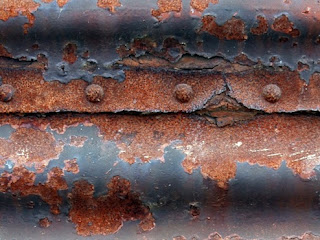Does Acid make steel rust faster?
Introduction
Rust
causes major destruction in different parts of the world. It destroys iron
corrugated houses roofs, fella fridges, cars, sink ships and so on. Rust is referred to as the evil and great
destroyer. In U.S rust costs Americans
nearly $ 4000 yearly greater than the cost of all the natural disaster combined. Rust is a reddish brown substance formed on
the surface of metals like steel and aluminum. Rust is an electrochemical
process that needs the presence of an electrolyte (Fe), oxygen (O) and water (H2O),
which electrolytes react with oxygen in the presence of water to form an iron
(iii) oxide or FeO3.H2O. When water consisting of small
quantity of dissolved oxygen, the electrolyte (Fe) is oxidized as shown in the
equation:
Fe(s) →Fe2+
(aq) + 2e-
The
electrons produced in the process are quickly accepted by the dissolved oxygen
(O2 (aq)) and hydrogen ions from water and this reaction occur at
the edge of the water to produce water.
O2 (aq) +
4H+ + 4e- →H2O (l)
When
water is made acidic, the corrosion rate also increases. In early studies, it
was observed that when the pH is very low (more acidic), the hydrogen ions will
take up electrons, but yield hydrogen gas instead of water.
2H+ + 2e- →H2
(g)
As
the iron corrodes, the hydrogen ions are consumed in the rusting process and
the pH of the water rises, at this moment, hydroxyl ions (-OH) start
forming in water. The resulting hydroxyl ions react with iron (ii) ions (Fe2+)
to give green insoluble iron (ii) hydroxides (green rust).
(-OH)(aq) +
Fe2+ (aq) →Fe (OH) 2(s)
The
produced iron (ii) hydroxide further reacts with hydrogen to produce iron (iii)
ions;
4H+ + O2
(aq) + 4Fe2+(aq) →2H2O(aq) + 4Fe3+(aq)
The
resultant iron (iii) ions react with hydroxide ions to yield hydrated iron
(iii) hydroxide (oxides):
3(-OH) (aq)
+ Fe3+ (aq) →Fe (OH) 3(s)
The
Fe (OH) 3 can easily changes to into crystallized form (Fe2O3.H2O),
which is the reddish-brown substance formed the surface of metals (rust).
Steel
is an iron alloy, composed of different elements with the carbon as the major
component. Since the steel contains an iron element, it is therefore affected
by rust. The objective of this paper was
to employ the use of less expensive and non-hazardous materials to determine
the link between the rust formation and the acid. The hypotheses of the study
were: (1) the temperature will increase with the decrease in the pH (solution
becoming more acidic). (2)The steel wool in the in acidic setup will rust
faster than steel wool in the distilled water system due to the presence of
more hydrogen ions which speed up the rusting process. (3) The temperature will
rise when the steel wool is in contact with the acid as the result of the
oxidation process.
Materials
and methods
Lemon juice, vinegar, distilled water;
thermometer, stopwatch and electrode pH meter, disposable gloves, quality steel
wool, three test tubes, three small bowls, ruler (15cm), scissors, tall plastic
cup and thin towel were used in this experiment. The independent variables were
pH and time while the dependent variables were mass, temperature and length of
the formation of rust.
Three
iron wool pads of 1 inch were prepared and put aside. A 10ml of lemon juice, vinegar, and distilled
water were measured and poured into the three small bowls distinctively (each
solution per each small bowl). The thermometer was inserted in the rubber
stopper and then placed in a test tube, followed by recording the temperature
of the thermometer (in degree Celsius). One of the prepared steel wool pads was
soaked in the lemon juice for 30 seconds. After 30 minutes, the steel wool pad
was taken out and the excess liquid was squeezed out from it. The thermometer
was quickly removed from the test tube and the soaked steel wool pad placed
onto the thermometer beneath the rubber stopper. The thermometer was returned
in a test tube, following by closing the stopper. The test tube was wrapped
with a thin towel and placed upright position in the tall plastic cup to ensure
that the thermometer readings are visible.
The
stopwatch was started and the temperature was recording (in degree Celsius) in
the sequence of 0, 1, 5 and 10 minutes. The thermometer was removed from the
test tube and the steel wool pad examined, followed by measuring its length and
width using 15 centimeters ruler (measurement taken in inches). This procedure was repeated for vinegar and
distilled water solutions. The pH of each solution was taken using electrode pH
meter.
Results
and discussion
For
the orange juice, before the prepared steel wool pad was soaked in the orange
solution, the steel wool pad was grey in color. After the soaking, the steel
pad turned to reddish brown and the bottom of the test tube was light brown in
color. The steel wool pad became hard, shrunk and its length increased with
time, from 1 inch at 0 minutes to the maximum length of 1.8 inches while its
width remained unchanged (1 inch). The temperature also rose from 25.8 degree
Celsius to a maximum temperature of 35 degree Celsius. On the other hand, in the vinegar solution,
the steel wool pad after soaking changed to reddish brown, and the test tube
bottom had light brown color. The steel wool pad shortened in size in the
formed circle. The steel wool pad became hard and this hardness made the steel
wool pad pieces to fall off. The length
of the wool pad became shorter while its width lengthened from 1 inch to 2
inches. The temperature the steel wool pad increased from 26 to a maximum
temperature of thirty-seven degree Celsius.
For
distilled water, the grey color of the steel wool pad persisted with an
exception of small observable brown spots. The temperature of the wool pad
remained unchanged (25 degree Celsius) while its length slightly changed at 10
minutes, and there was no change in its width. The rate of rust formation was
greater in vinegar, followed by lemon juice while there was no significant
formation in distilled water.
Conclusion and reflections
The
results indicated that the rust formation was paramount in the acid solution
(lemon juice and vinegar) and slight notable rust formation with distilled
water. The rate of rust formation in the acids varied with the concentration of
the acids. The vinegar (pH=3.09) which is less acidic than lemon juice (pH=2.60)
recorded greater quantities of rust as compared with the rust formed by the
lemon juice. The vinegar recorded high temperatures for all the trial performed
while the temperatures obtained from lemon the steel wool pad soaked in lemon
juice were higher than temperatures of the wool pad soaked in distilled
water. The difference between the
starting and ending temperature was highest in vinegar solution than in the
lemon juice and distilled water.
The
results showed that the acid increased the rate of rust formation and the
rate differ according to the concentration of the acid, for instance, vinegar
had a pH=3.09 resulted in the formation of the high amount of rust while the
lemon juice which had a pH=2.60 recorded
less rust formation as compared to vinegar. Therefore, the first hypothesis of
this paper was disapproved. The rust formation did not increase at lower pH.
However, the remaining hypotheses were justified. The temperature increased when
the steel wool was in contact with the acid due to oxidation process and the
acid fastened the rate of rust formation.
References
Hu, J., Cao,
S., Li, Y., Liang, Q., & Xie, J. (2012). Study on the corrosion behavior of
Q235A carbon steel in RO product water of seawater. Anti - Corrosion Methods
and Materials, 59(6), 305-310.
doi:http://dx.doi.org/10.1108/00035591211274424
Javaherdashti,
R. (2000). How corrosion affects industry and life. Anti - Corrosion Methods
and Materials, 47(1), 30. Retrieved from
http://search.proquest.com/docview/218891812?accountid=45049







Comments
Post a Comment